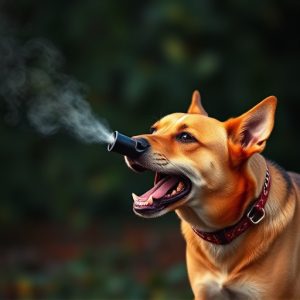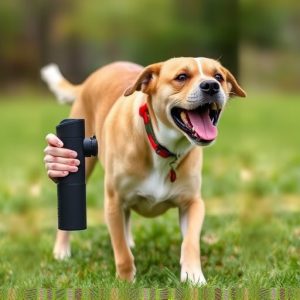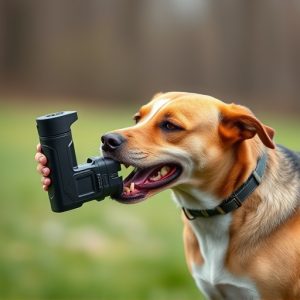Unveiling Mace Formula Animal Pepper Spray for Dog Defense
Understanding pepper spray formulations is key to effectively deterring aggressive dogs. Sprays cont…….
Understanding pepper spray formulations is key to effectively deterring aggressive dogs. Sprays contain capsaicin from chili peppers, with additives like oils and preservatives, measured in Scoville Heat Units (SCU). Higher SCU levels temporarily disorient dogs, while specific extracts and innovative delivery systems enhance safety and effectiveness. Targeting the dog's face at a distance ensures safe usage as a last resort against imminent threats.
“Uncover the power of pepper spray as a defense against aggressive dogs with our comprehensive guide. Understanding the science behind various pepper spray formulations is key to ensuring efficacy in real-world scenarios. We explore the active ingredients, including unique mace formulas, and their impact on canine behavior. This article delves into the key components that make up animal pepper spray, providing insights for responsible usage strategies against dogs. Armed with knowledge, learn how to navigate encounters effectively.”
- Understanding Pepper Spray Formulations and Their Efficacy Against Dogs
- Key Components of Mace Formula Animal Pepper Spray: A Deep Dive
- Safety Measures and Effective Usage Strategies for Pepper Spray Against Aggressive Dogs
Understanding Pepper Spray Formulations and Their Efficacy Against Dogs
Understanding Pepper spray formulations is key to determining their efficacy against aggressive dogs. These sprays are designed with a blend of capsaicin, the active ingredient derived from chili peppers, and other additives like oils or preservatives. The formula’s strength, measured in SCU (Scoville Heat Units), indicates its potential impact on canine behavior. Higher concentrations can be effective in disorienting and temporarily incapacitating dogs, especially when responding to threats or attacks.
When it comes to pepper spray formulations against aggressive dogs, specific ingredients play a crucial role. For instance, some products incorporate natural extractions known for their soothing properties, aiming to minimize potential harm to the dog’s eyes and respiratory system. Additionally, advancements in technology have led to innovative delivery systems that ensure a precise application, maximizing the spray’s effectiveness while minimizing off-target effects.
Key Components of Mace Formula Animal Pepper Spray: A Deep Dive
The pepper spray formulation designed for aggressive dogs is a carefully crafted blend of active ingredients aimed at effectively deterring and incapacitating these animals without causing permanent harm. At its core, this formula typically includes capsaicin, the active compound found in chili peppers responsible for the burning sensation associated with pepper spray. However, unlike traditional pepper sprays, the mace formula for animal use often incorporates additional components to enhance its effectiveness against larger, more powerful dogs.
One key addition is a synergistic blend of chemicals that potentiate capsaicin’s effects, making it more potent and longer-lasting. These include various amines and other compounds known for their ability to disrupt an animal’s sensory perception and balance. Moreover, the formulation may contain agents that help penetrate protective barriers like mucus membranes, ensuring direct contact with sensitive areas. This combination ensures that even highly aggressive dogs experience a strong physiological response, temporarily disorienting them and providing valuable time for escape or intervention.
Safety Measures and Effective Usage Strategies for Pepper Spray Against Aggressive Dogs
When using pepper spray against aggressive dogs, safety should be your top priority. Always ensure you have a clear line of sight to the target animal and maintain a safe distance. Pepper spray is designed to disrupt an attacker’s vision, breathing, and balance, allowing you to escape or defuse the situation. However, it’s crucial not to get too close, as this could result in direct exposure to the spray, which may cause temporary blindness, coughing, and respiratory distress for both you and bystanders.
Effective usage strategies involve aiming for the dog’s face and eyes, as these areas are highly sensitive. Use a swift motion to release the spray, creating a cloud of mist that obscures the dog’s vision. Keep moving after spraying to maintain distance, allowing the effects to wear off. Remember, pepper spray is a temporary deterrent; it’s best used as a last resort when facing an imminent threat from an aggressive dog.
In understanding the effectiveness of pepper spray formulations against aggressive dogs, it’s clear that mace-based animal sprays can be a powerful tool for self-defense. By examining key components and safety measures, individuals can make informed decisions about their suitability as deterrents. Remember, responsible usage strategies are crucial to ensure maximum efficacy while minimizing potential risks. When used appropriately, pepper spray formulations can serve as reliable game changers in navigating challenging encounters with aggressive canines.


